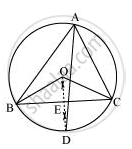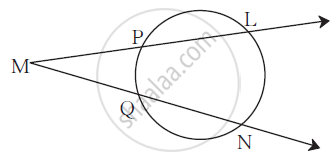Advertisements
Advertisements
प्रश्न
In any triangle ABC, if the angle bisector of ∠A and perpendicular bisector of BC intersect, prove that they intersect on the circumcircle of the triangle ABC.
उत्तर

Let perpendicular bisector of side BC and angle bisector of ∠A meet at point D. Let the perpendicular bisector of side BC intersect it at E.
Perpendicular bisector of side BC will pass through circumcentre O of the circle. ∠BOC and ∠BAC are the angles subtended by arc BC at the centre and a point A on the remaining part of the circle respectively. We also know that the angle subtended by an arc at the centre is double the angle subtended by it at any point on the remaining part of the circle.
∠BOC = 2 ∠BAC = 2 ∠A ... (1)
In ΔBOE and ΔCOE,
OE = OE (Common)
OB = OC (Radii of same circle)
∠OEB = ∠OEC (Each 90° as OD ⊥ BC)
∴ ΔBOE ≅ ∠COE (RHS congruence rule)
∠BOE = ∠COE (By CPCT) ... (2)
However, ∠BOE + ∠COE = ∠BOC
⇒ ∠BOE +∠BOE = 2 ∠A [Using equations (1) and (2)]
⇒ 2 ∠BOE = 2 ∠A
⇒ ∠BOE = ∠A
∴ ∠BOE = ∠COE = ∠A
The perpendicular bisector of side BC and angle bisector of ∠A meet at point D.
∴ ∠BOD = ∠BOE = ∠A ... (3)
Since AD is the bisector of angle ∠A,
∠BAD = ∠A/2
⇒ 2 ∠BAD = ∠A ... (4)
From equations (3) and (4), we obtain
∠BOD = 2 ∠BAD
This can be possible only when point BD will be a chord of the circle. For this, the point D lies on the circum circle.
Therefore, the perpendicular bisector of side BC and the angle bisector of ∠A meet on the circum circle of triangle ABC.
APPEARS IN
संबंधित प्रश्न
Prove that "Opposite angles of a cyclic quadrilateral are supplementary".
Prove that a cyclic parallelogram is a rectangle.
Prove that the circle drawn with any side of a rhombus as diameter passes through the point of intersection of its diagonals.
ABCD is a parallelogram. The circle through A, B and C intersect CD (produced if necessary) at E. Prove that AE = AD.
Two chords AB and CD of lengths 5 cm 11cm respectively of a circle are parallel to each other and are on opposite sides of its centre. If the distance between AB and CD is 6 cm, find the radius of the circle.

In the figure m(arc LN) = 110°,
m(arc PQ) = 50° then complete the following activity to find ∠LMN.
∠ LMN = `1/2` [m(arc LN) - _______]
∴ ∠ LMN = `1/2` [_________ - 50°]
∴ ∠ LMN = `1/2` × _________
∴ ∠ LMN = __________
ABCD is a cyclic quadrilateral in ∠BCD = 100° and ∠ABD = 70° find ∠ADB.
ABCD is a cyclic quadrilateral in which BA and CD when produced meet in E and EA = ED. Prove that EB = EC.
If a pair of opposite sides of a cyclic quadrilateral are equal, prove that its diagonals are also equal.
ABCD is a parallelogram. A circle through A, B is so drawn that it intersects AD at P and BC at Q. Prove that P, Q, C and D are concyclic.
